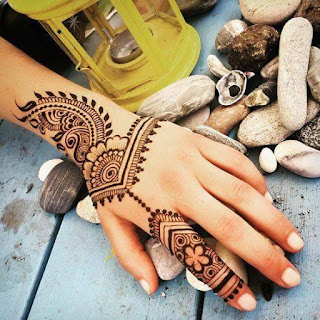How The Henna Hue and Designs Evolved from Medieval to A Global Art Form.
By
Nana Sule
From head to toe, the henna has infinite
uses for the human body and mind. These range from medicinal utility, beautification,
mummification, spirituality to decorative body art, such that henna and the art
of its application are now widespread across cultures and religions.
In
present times, it is no surprise to see periods specially carved into wedding
programs for the artistic designs of hands and feet. This is an art widespread
amongst the women of Northern Nigeria. These designs, known amongst Nigerian
women as Lalle, or Henna are beautiful and temporal tattoos
drawn on hands and feet of females at weddings, naming ceremonies, festivals
and even on normal days as means of beautification.
However,
long before the modern day commercialization of the body art, where artists
charge quite lump sums at weddings and other festivities, were days that saw
the henna design used for more than just body designs.
The
origin of henna is traced to the Bronze Age and the Roman Period. Around 3500
BC, henna found its way into North
Africa. Here, these species of the Lawania leaves were ground into a paste and
applied as dye to hair. In Egypt, they were used to decorate nails of mummies,
and to treat skin irritations and mild diseases on the skin. In fact, it was
used first by men who added it to their beards to achieve a rich brown/reddish
color and to conceal graying hair.
The
coming of Europeans however into North Africa influenced the development of
Henna art in the negative, at first. Some scholars argue that this may have
been because of the promotion of European wears and cosmetics over the twigs
and simple artistic beauty material that was the henna paste, while others argue that perhaps the Europeans may have
attributed it to certain beliefs that the designs were simply backward and not
meant for proper civilization.
However,
after the liberation of North Africa, Henna
art started to prosper once more, mostly owing to the Islamization of the North
African Countries. This made the henna
plant an economic good, as it was being packaged and treated as export material
to other countries within Africa.
Henna designs are thought to have originally spread in West
Africa through the Tuareg Communities of the Sahara. In his book, The Book of Roads and Kingdoms, al- Bakri (1014-1094) wrote about the
city of Awdaghust, which he described
as a city of numerous palms and henna
trees. The ruins of this ancient city is now located in South Central
Mauritania. Other areas where history records growth of the henna plant were
the Hausa lands; Niger, Northern Nigeria, and Ports of Burkina Faso and Ghana.
It is therefore a bit unclear if the importation of ground henna leaves formed the basis for the recognition of Henna plants in West Africa, or if they
were already identified and being put to use by the Tuaregs of the Sahara and
gradually introduced to the Hausa lands. This is because the henna in Nigeria is called the lalle, a variation from the Tuaregs anelle.
Another
angle of origination would come from Arabs and the religious teachings. Here,
scholars believe the Islamic prophet Muhammad had commanded the females in his
congregation to adorn their hands with henna as a means of distinguishing their
hands from the hands of the males. Hence some believe the henna to have come
with the Islamization of some Hausa lands such that by the 19th
Century in Borno Empire and the Fulani Empire in Sokoto, men were recorded to
have their beards dyed while women explored hand and feet designs at weddings
and Eid celebrations.
Today,
there exist innumerable patterns and designs of the henna largely inspired by
cultural and religious traditions and even contemporary styles. Some designs
come in geometric shapes with abstract symbols; others come in floral designs,
lines and dots.
Interestingly,
the use of henna during wedding ceremonies is not limited to the brides alone.
Some African ethnic groups such as the Nupe and the Tuareg indulge their grooms
as well with sparse application of henna to their hands.
From
Africa, to Asia and to Europe, and still extending and growing as one major
area of economic importance to women financial independence and liberation, one
thing is certain about the henna; it is a beautiful and accepted work of art. In
contemporary times, chemicals are being added to the paste to give it longer
stain time, as well as explore other colors such as black, green, and blue from
its original reddish/brownish color. While the designs from these modern
mixtures are pleasant to the eye, a lot of concern is being raised about the
degree of effects it has on the skin.
Now,
with twigs, or the more common cones and syringe, anyone can get a henna design. Accepted by major faiths
around the world; Jews, Muslims, Sikhs, Hindus, and some Christians have their
brides adorned with splendid designs on days before their weddings, while
allowing for females of all ages to wear the designs as part of their daily
beauty accessories.
So,
if you are wearing a henna design today, think how its use has evolved from
mummification, to skin remedies, to hair dye for men and finally to the palm of
your hand and soles of your feet. Think also, how it would look on the beards
of Nigerian men.
------------------------------------------
Nana Sule is a contributing writer at The Arts-Muse Fair. An Environmental enthusiast, her writings have appeared in blogs. She is the Coordinator of the Minna Book Club and tweets @izesule.
------------------------------------------
Nana Sule is a contributing writer at The Arts-Muse Fair. An Environmental enthusiast, her writings have appeared in blogs. She is the Coordinator of the Minna Book Club and tweets @izesule.



Interesting read. Thanks for the enlightment about henna. Thumbs up Nana Hauwa.
ReplyDelete